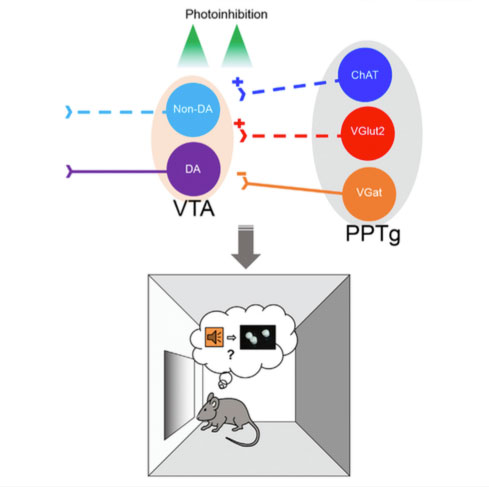Featured Paper of the Month – January 2017
Yau, Hau-Jie; Wang, Dong V; Tsou, Jen-Hui; Chuang, Yi-Fang; Chen, Billy T; Deisseroth, Karl; Ikemoto, Satoshi; Bonci, Antonello
Pontomesencephalic Tegmental Afferents to VTA Non-dopamine Neurons Are Necessary for Appetitive Pavlovian Learning. Journal Article
In: Cell Rep, vol. 16, no. 10, pp. 2699–2710, 2016, ISSN: 2211-1247 (Electronic).
@article{Yau2016,
title = {Pontomesencephalic Tegmental Afferents to VTA Non-dopamine Neurons Are Necessary for Appetitive Pavlovian Learning.},
author = {Hau-Jie Yau and Dong V Wang and Jen-Hui Tsou and Yi-Fang Chuang and Billy T Chen and Karl Deisseroth and Satoshi Ikemoto and Antonello Bonci},
url = {https://www.ncbi.nlm.nih.gov/pubmed/27568569},
doi = {10.1016/j.celrep.2016.08.007},
issn = {2211-1247 (Electronic)},
year = {2016},
date = {2016-09-06},
journal = {Cell Rep},
volume = {16},
number = {10},
pages = {2699--2710},
address = {Synaptic Plasticity Section, Intramural Research Program, National Institute on Drug Abuse, NIH, U.S. Department of Health and Human Services, Baltimore, MD 21224, USA; Graduate Institute of Brain and Mind Sciences, National Taiwan University, Taipei 10051, Taiwan.},
abstract = {The ventral tegmental area (VTA) receives phenotypically distinct innervations from the pedunculopontine tegmental nucleus (PPTg). While PPTg-to-VTA inputs are thought to play a critical role in stimulus-reward learning, direct evidence linking PPTg-to-VTA phenotypically distinct inputs in the learning process remains lacking. Here, we used optogenetic approaches to investigate the functional contribution of PPTg excitatory and inhibitory inputs to the VTA in appetitive Pavlovian conditioning. We show that photoinhibition of PPTg-to-VTA cholinergic or glutamatergic inputs during cue presentation dampens the development of anticipatory approach responding to the food receptacle during the cue. Furthermore, we employed in vivo optetrode recordings to show that photoinhibition of PPTg cholinergic or glutamatergic inputs significantly decreases VTA non-dopamine (non-DA) neural activity. Consistently, photoinhibition of VTA non-DA neurons disrupts the development of cue-elicited anticipatory approach responding. Taken together, our study reveals a crucial regulatory mechanism by PPTg excitatory inputs onto VTA non-DA neurons during appetitive Pavlovian conditioning.},
keywords = {},
pubstate = {published},
tppubtype = {article}
}
The ventral tegmental area (VTA) receives phenotypically distinct innervations from the pedunculopontine tegmental nucleus (PPTg). While PPTg-to-VTA inputs are thought to play a critical role in stimulus-reward learning, direct evidence linking PPTg-to-VTA phenotypically distinct inputs in the learning process remains lacking. Here, we used optogenetic approaches to investigate the functional contribution of PPTg excitatory and inhibitory inputs to the VTA in appetitive Pavlovian conditioning. We show that photoinhibition of PPTg-to-VTA cholinergic or glutamatergic inputs during cue presentation dampens the development of anticipatory approach responding to the food receptacle during the cue. Furthermore, we employed in vivo optetrode recordings to show that photoinhibition of PPTg cholinergic or glutamatergic inputs significantly decreases VTA non-dopamine (non-DA) neural activity. Consistently, photoinhibition of VTA non-DA neurons disrupts the development of cue-elicited anticipatory approach responding. Taken together, our study reveals a crucial regulatory mechanism by PPTg excitatory inputs onto VTA non-DA neurons during appetitive Pavlovian conditioning.

